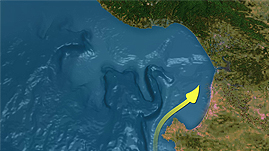Teachers' Domain - Digital Media for the Classroom and Professional Development
User: Preview


Source: Jean-Michel Cousteau: Ocean Adventures "Gray Whale Obstacle Course"



The migration of gray whales (Eschrichtius robustus) is the longest of any known marine mammal. This video, adapted from Jean-Michel Cousteau’s Ocean Adventures outlines their exciting 10,000-mile journey along America’s Pacific Coast.
Migration in animals is defined as the mass movement from one region to another. In most cases, seasonal changes in climate or changes in the local food supply trigger this movement. Migration in animals is often, but not always, cyclical. This means that most animals return to a place they leave, but some don’t.
There are many of types of migration. The most common involves animals moving to a new location when the seasons change to find warmer weather farther south. Others move across major land features like mountains ranges or deserts in order to find a more plentiful supply of food. In addition to food and climate, animal migrations also involve moving to a different area to bear young. Migratory destinations are usually safer for offspring because there are fewer or no predators. The landscape in the new environment may also provide better natural shelter from predatory animals.
There are many incredible animal migrations. Monarch butterflies make a 2,000-mile, multi generational migration from summers in North America to winters in central Mexico. In the case of this butterfly, the insects that begin this migration die before reaching their destination. Their offspring continue and complete the journey, and their great-great-grandchildren return to the same North American locations the next year.
Salmon, possibly the most well-known migrating animals, start their lives in freshwater streams but move to the open ocean for their adult lives and return to their freshwater birthplace to lay their eggs.
How these animals manage to find their way across thousands of miles is a feat that scientists continue to research and debate. Many animals follow familiar landmarks like coastlines, mountain ranges and river valleys. There is also evidence that animals inherit migratory routes from their parents.
Human activity has created a number of problems for migrating animals. As the human population continues to grow, development encroaches on animal habitats. Large-scale changes in the environment are known to confuse migrating animals. Physical barriers resulting from development, such as roads and fences, are also a problem, although some structures like large dams sometimes include features that allow salmon and other fish to reach their home streams.
To learn more about Animal Migrations, take a look at Ladybug Pajama Party and Migration of the Monarch.
 Loading Standards
Loading Standards